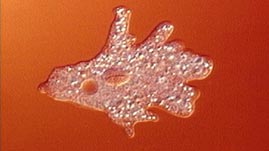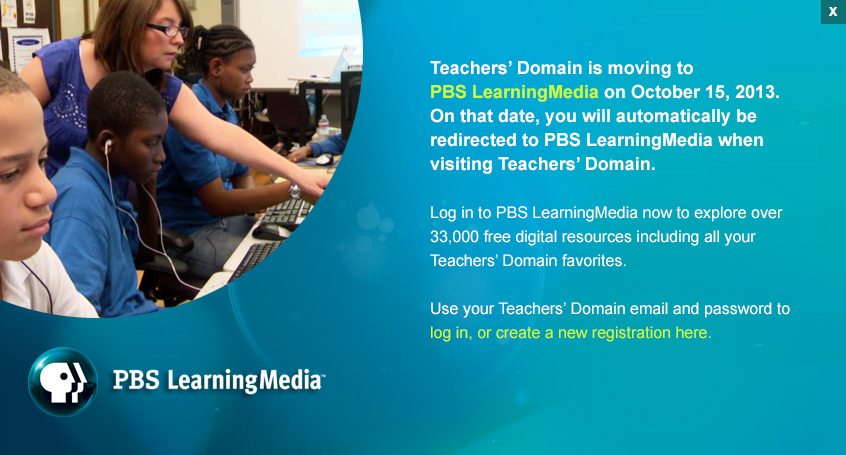Teachers' Domain - Digital Media for the Classroom and Professional Development
User: Preview

Source: Produced for Teachers' Domain
They're neither plants nor animals, yet they are some of the most important life forms on Earth. This video segment explores the world of microorganisms -- what they eat, how they move, what they have in common, and what distinguishes them from one another.
Single-Celled Organisms (Audio Description) (Video)
The diversity of single-celled organisms is astounding. These differences are apparent in both the structure and function of the organisms. For starters, single-celled organisms range greatly in size, from less than 1 micron (one-millionth of a meter) in diameter for the smallest bacteria, to more than 100 microns for some protozoans.
The manner in which single-celled organisms acquire food varies greatly too. Some, like the amoeba, go in search of food, crawling on pseudopods (temporary bulges in the cell membrane) toward prey that they eventually engulf and digest internally. Others, including all of the different species of algae, make their own food by harnessing the sun's energy just as plants do. Structures called chloroplasts inside the algae contain the pigment chlorophyll that allows them to use the sun's energy to make carbohydrates from carbon dioxide and water.
Several types of algae are so versatile that, depending on light conditions, they change the mode by which they obtain food. When sunlight is available, Euglena can be seen gravitating toward the light, which they sense through a photoreceptor, or eyespot, at one end of the cell. If the light is too bright, the organisms will swim away toward more optimal light conditions. If no sunlight is available, however, Euglena have the ability to transition entirely to absorbing nutrients from the water. They may acquire their food this way indefinitely, assuming sufficient nutrients are available and light is not.
Single-celled organisms reproduce in some interesting and surprisingly efficient ways. While some rely on hosts or a series of host species to complete their complex life cycles, many reproduce by simply dividing in two. In fact, the biological success and remarkable diversity of single-celled organisms is due, at least in part, to their rapid rate of cell division. Growing under optimal conditions, the common bacterium Escherichia coli, for example, can double its population size in just 20 minutes. (Contrast that with humans, who take on average 20 years to produce a single offspring.) Within weeks, a population of E. coli bacteria can virtually reinvent itself. Given that the time required for one individual to pass its genes to the next generation is one of the most important factors in the evolutionary process, single-celled organisms are on the evolutionary fast track!
In recent decades, this phenomenon has pitted doctors and researchers against quickly evolving bacteria in an anxious battle over antibiotic resistance. Experts now estimate that as many as two dozen types of bacteria have evolved resistance to most, if not all, antibiotics available today. A battle that we had been winning handily for 50 years, thanks to advances in medicine, appears now to be an even match.
NARRATOR: All living things are made up of one or more cells: trees...elephants...moss...a paramecium. Sometimes, a cell is the organism.
Single-celled, or unicellular, organisms do many of the same things as multicellular organisms. They grow, eat, excrete and reproduce. There are two basic types of cells. Those without nuclei are called prokaryotes. Their DNA floats freely through the cytoplasm. In eukaryotes, a cell nucleus protects the DNA.
Single-celled organisms can move in different ways. This Paranema, 1/50,000 of a millimeter long, has an especially thick flagellum that pushes it forward. Other organisms have cilia, hairlike structures that are effective motors for moving through water...for walking over surfaces...for bringing food toward the cell.
An amoeba moves by reaching out its flexible membrane and forming a pseudopod, or false foot. The cytoplasm of the amoeba streams into the pseudopod, and the rest of the cell follows.
Within the single cell are organelles that carry out life processes such as digestion...respiration...and water regulation. In this paramecium, the contractile vacuole collects excess water. Then, when it's full, it suddenly contracts and pumps water out.
Here, an amoeba engulfs a green Euglena. It forms a food vacuole, where it will digest its prey and pass on nutrients to the rest of the cell. The cell membrane controls the flow of nutrients, oxygen and waste into and out of the cell.
Found in almost all eukaryotic cells, mitochondria are organelles that break down food and release energy. These long cells with green chloroplasts are Euglenas. Their red eyespots help them find sunlight, and as long as there is light, they obtain energy through photosynthesis, just like plants.
A species must be able to reproduce, to pass on its genes to the next generation. When a single-celled organism reproduces, it duplicates its DNA, with each daughter cell receiving a complete copy of the parent's genes.
 Loading Standards
Loading Standards Teachers' Domain is proud to be a Pathways portal to the National Science Digital Library.
Teachers' Domain is proud to be a Pathways portal to the National Science Digital Library.
